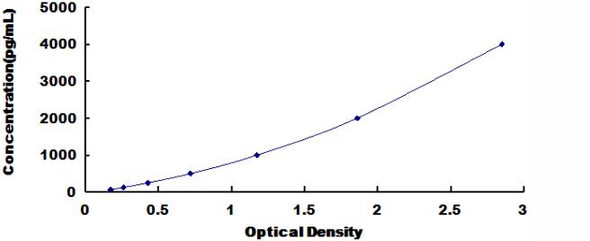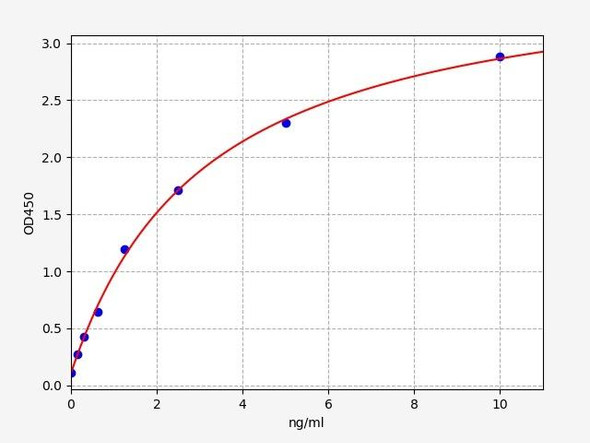Human PGD2S / Prostaglandin D2 Synthase, Brain ELISA Kit (HUFI02731)
- SKU:
- HUFI02731
- Product Type:
- ELISA Kit
- Size:
- 96 Assays
- Uniprot:
- P41222
- Sensitivity:
- 37.5pg/ml
- Range:
- 62.5-4000pg/ml
- ELISA Type:
- Sandwich
- Synonyms:
- PGD2S, Cerebrin-28, PDS, PGD2, PGDS2, PH2DISO, PTGDS, Beta-trace protein, cerebrin-28, Cerebrin-28, EC 5.3.99.2, Glutathione-independent PGD synthase, glutathione-independent PGD synthetase, lipocalin-type prostaglandin D synthase, Lipocalin-type pro
- Reactivity:
- Human
- Research Area:
- Metabolism
Description
Human PGD2S/Prostaglandin D2 Synthase, Brain ELISA Kit
The Prostaglandin D2 Synthase (PGD2S) ELISA Kit is specifically designed for the accurate measurement of PGD2S levels in human brain tissue samples. This kit offers high sensitivity and specificity, ensuring consistent and reliable results for researchers studying the role of PGD2S in various neurological conditions.PGD2S is an enzyme that plays a crucial role in the synthesis of prostaglandin D2, a key mediator of inflammation and immune responses in the brain. Dysregulation of PGD2S has been implicated in conditions such as Alzheimer's disease, Parkinson's disease, and multiple sclerosis, making it a valuable biomarker for understanding the pathogenesis of these disorders and identifying potential therapeutic targets.
With its easy-to-use protocol and accurate detection capabilities, the PGD2S ELISA Kit is an essential tool for researchers and clinicians studying the intricate mechanisms of brain inflammation and neurodegenerative diseases.
| Product Name: | Human PGD2S / Prostaglandin D2 Synthase, Brain ELISA Kit |
| Product Code: | HUFI02731 |
| Size: | 96 Assays |
| Alias: | PGD2S, Cerebrin-28, PDS, PGD2, PGDS2, PH2DISO, PTGDS, Beta-trace protein, cerebrin-28, Cerebrin-28, EC 5.3.99.2, Glutathione-independent PGD synthase, glutathione-independent PGD synthetase, lipocalin-type prostaglandin D synthase, Lipocalin-type prostaglandin-D synthase, L-PGDS, PDS, PGD2, PGD2 synthase, PGDS2, PGDSLPGDS, prostaglandin D synthase, prostaglandin D2 synthase, 21kD, brain, prostaglandin D2 synthase 21kDa, brain, Prostaglandin-D2 synthase, prostaglandin-H2 D-isomerase |
| Detection method: | Sandwich ELISA, Double Antibody |
| Application: | This immunoassay kit allows for the in vitro quantitative determination of Human PGD2S concentrations in serum plasma and other biological fluids. |
| Sensitivity: | 37.5pg/ml |
| Range: | 62.5-4000pg/ml |
| Storage: | 4°C for 6 months |
| Note: | For Research Use Only |
| Recovery: | Matrices listed below were spiked with certain level of Human PGD2S and the recovery rates were calculated by comparing the measured value to the expected amount of Human PGD2S in samples. | ||||||||||||||||
| |||||||||||||||||
| Linearity: | The linearity of the kit was assayed by testing samples spiked with appropriate concentration of Human PGD2S and their serial dilutions. The results were demonstrated by the percentage of calculated concentration to the expected. | ||||||||||||||||
| |||||||||||||||||
| CV(%): | Intra-Assay: CV<8% Inter-Assay: CV<10% |
| Component | Quantity | Storage |
| ELISA Microplate (Dismountable) | 8×12 strips | 4°C for 6 months |
| Lyophilized Standard | 2 | 4°C/-20°C |
| Sample/Standard Dilution Buffer | 20ml | 4°C |
| Biotin-labeled Antibody(Concentrated) | 120ul | 4°C (Protect from light) |
| Antibody Dilution Buffer | 10ml | 4°C |
| HRP-Streptavidin Conjugate(SABC) | 120ul | 4°C (Protect from light) |
| SABC Dilution Buffer | 10ml | 4°C |
| TMB Substrate | 10ml | 4°C (Protect from light) |
| Stop Solution | 10ml | 4°C |
| Wash Buffer(25X) | 30ml | 4°C |
| Plate Sealer | 5 | - |
Other materials and equipment required:
- Microplate reader with 450 nm wavelength filter
- Multichannel Pipette, Pipette, microcentrifuge tubes and disposable pipette tips
- Incubator
- Deionized or distilled water
- Absorbent paper
- Buffer resevoir
| Uniprot | P41222 |
| UniProt Protein Function: | PTGDS: Catalyzes the conversion of PGH2 to PGD2, a prostaglandin involved in smooth muscle contraction/relaxation and a potent inhibitor of platelet aggregation. Involved in a variety of CNS functions, such as sedation, NREM sleep and PGE2-induced allodynia, and may have an anti-apoptotic role in oligodendrocytes. Binds small non-substrate lipophilic molecules, including biliverdin, bilirubin, retinal, retinoic acid and thyroid hormone, and may act as a scavenger for harmful hydrophopic molecules and as a secretory retinoid and thyroid hormone transporter. Possibly involved in development and maintenance of the blood-brain, blood-retina, blood-aqueous humor and blood-testis barrier. It is likely to play important roles in both maturation and maintenance of the central nervous system and male reproductive system. Belongs to the calycin superfamily. Lipocalin family. |
| UniProt Protein Details: | Protein type:EC 5.3.99.2; Secreted; Endoplasmic reticulum; Lipid Metabolism - arachidonic acid; Secreted, signal peptide; Isomerase Chromosomal Location of Human Ortholog: 9q34.2-q34.3 Cellular Component: Golgi apparatus; extracellular space; endoplasmic reticulum membrane; nuclear membrane; rough endoplasmic reticulum; perinuclear region of cytoplasm; extracellular region Molecular Function:retinoid binding; prostaglandin-D synthase activity; transporter activity; fatty acid binding Biological Process: transport; cyclooxygenase pathway; response to glucocorticoid stimulus; arachidonic acid metabolic process; prostaglandin biosynthetic process; regulation of circadian sleep/wake cycle, sleep |
| NCBI Summary: | The protein encoded by this gene is a glutathione-independent prostaglandin D synthase that catalyzes the conversion of prostaglandin H2 (PGH2) to postaglandin D2 (PGD2). PGD2 functions as a neuromodulator as well as a trophic factor in the central nervous system. PGD2 is also involved in smooth muscle contraction/relaxation and is a potent inhibitor of platelet aggregation. This gene is preferentially expressed in brain. Studies with transgenic mice overexpressing this gene suggest that this gene may be also involved in the regulation of non-rapid eye movement sleep. [provided by RefSeq, Jul 2008] |
| UniProt Code: | P41222 |
| NCBI GenInfo Identifier: | 730305 |
| NCBI Gene ID: | 5730 |
| NCBI Accession: | P41222.1 |
| UniProt Secondary Accession: | P41222,Q5SQ10, Q7M4P3, Q9UC22, Q9UCC9, Q9UCD9, B2R727 |
| UniProt Related Accession: | P41222 |
| Molecular Weight: | 21kDa |
| NCBI Full Name: | Prostaglandin-H2 D-isomerase |
| NCBI Synonym Full Names: | prostaglandin D2 synthase 21kDa (brain) |
| NCBI Official Symbol: | PTGDS |
| NCBI Official Synonym Symbols: | PDS; PGD2; PGDS; LPGDS; PGDS2; L-PGDS |
| NCBI Protein Information: | prostaglandin-H2 D-isomerase; cerebrin-28; PGD2 synthase; beta-trace protein; prostaglandin D synthase; prostaglandin-D2 synthase; glutathione-independent PGD synthase; glutathione-independent PGD synthetase; lipocalin-type prostaglandin D synthase; lipocalin-type prostaglandin-D synthase |
| UniProt Protein Name: | Prostaglandin-H2 D-isomerase |
| UniProt Synonym Protein Names: | Beta-trace protein; Cerebrin-28; Glutathione-independent PGD synthase; Lipocalin-type prostaglandin-D synthase; Prostaglandin-D2 synthase; PGD2 synthase; PGDS; PGDS2 |
| Protein Family: | Prostaglandin-H2 D-isomerase |
| UniProt Gene Name: | PTGDS |
| UniProt Entry Name: | PTGDS_HUMAN |
*Note: Protocols are specific to each batch/lot. For the correct instructions please follow the protocol included in your kit.
Before adding to wells, equilibrate the SABC working solution and TMB substrate for at least 30 min at 37°C. When diluting samples and reagents, they must be mixed completely and evenly. It is recommended to plot a standard curve for each test.
| Step | Protocol |
| 1. | Set standard, test sample and control (zero) wells on the pre-coated plate respectively, and then, record their positions. It is recommended to measure each standard and sample in duplicate. Wash plate 2 times before adding standard, sample and control (zero) wells! |
| 2. | Aliquot 0.1ml standard solutions into the standard wells. |
| 3. | Add 0.1 ml of Sample / Standard dilution buffer into the control (zero) well. |
| 4. | Add 0.1 ml of properly diluted sample ( Human serum, plasma, tissue homogenates and other biological fluids.) into test sample wells. |
| 5. | Seal the plate with a cover and incubate at 37 °C for 90 min. |
| 6. | Remove the cover and discard the plate content, clap the plate on the absorbent filter papers or other absorbent material. Do NOT let the wells completely dry at any time. Wash plate X2. |
| 7. | Add 0.1 ml of Biotin- detection antibody working solution into the above wells (standard, test sample & zero wells). Add the solution at the bottom of each well without touching the side wall. |
| 8. | Seal the plate with a cover and incubate at 37°C for 60 min. |
| 9. | Remove the cover, and wash plate 3 times with Wash buffer. Let wash buffer rest in wells for 1 min between each wash. |
| 10. | Add 0.1 ml of SABC working solution into each well, cover the plate and incubate at 37°C for 30 min. |
| 11. | Remove the cover and wash plate 5 times with Wash buffer, and each time let the wash buffer stay in the wells for 1-2 min. |
| 12. | Add 90 µl of TMB substrate into each well, cover the plate and incubate at 37°C in dark within 10-20 min. (Note: This incubation time is for reference use only, the optimal time should be determined by end user.) And the shades of blue can be seen in the first 3-4 wells (with most concentrated standard solutions), the other wells show no obvious color. |
| 13. | Add 50 µl of Stop solution into each well and mix thoroughly. The color changes into yellow immediately. |
| 14. | Read the O.D. absorbance at 450 nm in a microplate reader immediately after adding the stop solution. |
When carrying out an ELISA assay it is important to prepare your samples in order to achieve the best possible results. Below we have a list of procedures for the preparation of samples for different sample types.
| Sample Type | Protocol |
| Serum | If using serum separator tubes, allow samples to clot for 30 minutes at room temperature. Centrifuge for 10 minutes at 1,000x g. Collect the serum fraction and assay promptly or aliquot and store the samples at -80°C. Avoid multiple freeze-thaw cycles. If serum separator tubes are not being used, allow samples to clot overnight at 2-8°C. Centrifuge for 10 minutes at 1,000x g. Remove serum and assay promptly or aliquot and store the samples at -80°C. Avoid multiple freeze-thaw cycles. |
| Plasma | Collect plasma using EDTA or heparin as an anticoagulant. Centrifuge samples at 4°C for 15 mins at 1000 × g within 30 mins of collection. Collect the plasma fraction and assay promptly or aliquot and store the samples at -80°C. Avoid multiple freeze-thaw cycles. Note: Over haemolysed samples are not suitable for use with this kit. |
| Urine & Cerebrospinal Fluid | Collect the urine (mid-stream) in a sterile container, centrifuge for 20 mins at 2000-3000 rpm. Remove supernatant and assay immediately. If any precipitation is detected, repeat the centrifugation step. A similar protocol can be used for cerebrospinal fluid. |
| Cell culture supernatant | Collect the cell culture media by pipette, followed by centrifugation at 4°C for 20 mins at 1500 rpm. Collect the clear supernatant and assay immediately. |
| Cell lysates | Solubilize cells in lysis buffer and allow to sit on ice for 30 minutes. Centrifuge tubes at 14,000 x g for 5 minutes to remove insoluble material. Aliquot the supernatant into a new tube and discard the remaining whole cell extract. Quantify total protein concentration using a total protein assay. Assay immediately or aliquot and store at ≤ -20 °C. |
| Tissue homogenates | The preparation of tissue homogenates will vary depending upon tissue type. Rinse tissue with 1X PBS to remove excess blood & homogenize in 20ml of 1X PBS (including protease inhibitors) and store overnight at ≤ -20°C. Two freeze-thaw cycles are required to break the cell membranes. To further disrupt the cell membranes you can sonicate the samples. Centrifuge homogenates for 5 mins at 5000xg. Remove the supernatant and assay immediately or aliquot and store at -20°C or -80°C. |
| Tissue lysates | Rinse tissue with PBS, cut into 1-2 mm pieces, and homogenize with a tissue homogenizer in PBS. Add an equal volume of RIPA buffer containing protease inhibitors and lyse tissues at room temperature for 30 minutes with gentle agitation. Centrifuge to remove debris. Quantify total protein concentration using a total protein assay. Assay immediately or aliquot and store at ≤ -20 °C. |
| Breast Milk | Collect milk samples and centrifuge at 10,000 x g for 60 min at 4°C. Aliquot the supernatant and assay. For long term use, store samples at -80°C. Minimize freeze/thaw cycles. |






